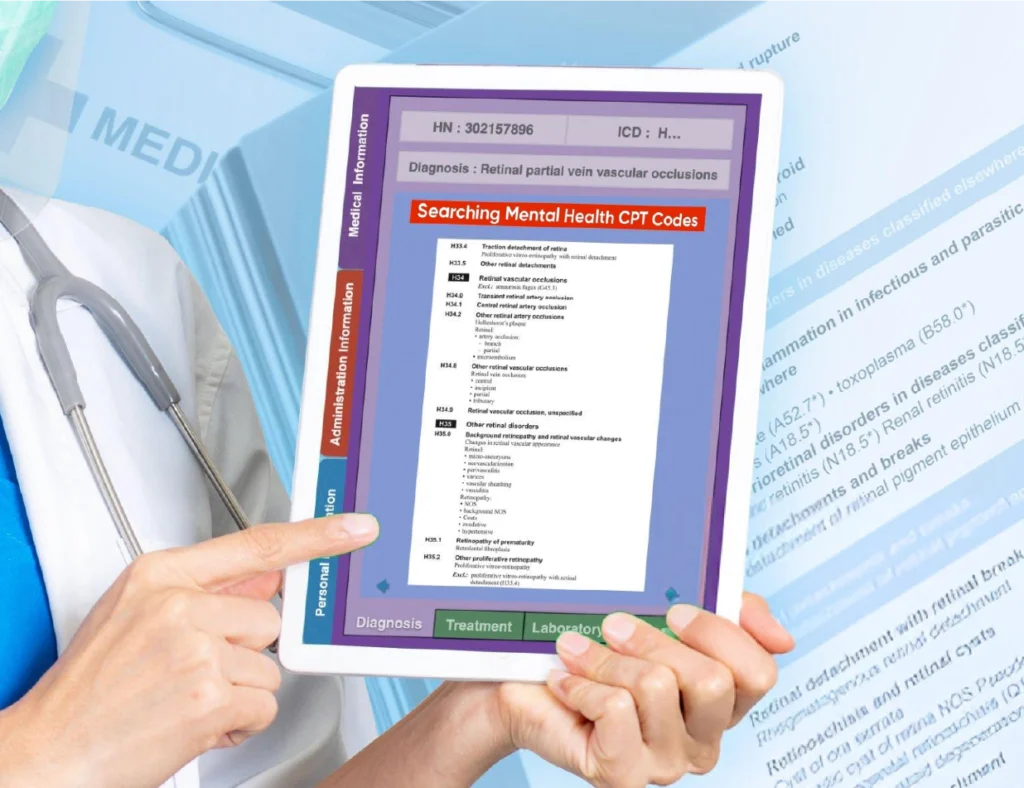
Mental Health Billing Guide: CPT Codes for Therapy & Psychiatry
Understanding Mental Health CPT Codes

CPT Codes for Therapy Services
| CPT Codes | Description |
|---|---|
| 90832 | Psychotherapy for 30 minutes with the patient |
| 90834 | Psychotherapy for 45 minutes |
| 90837 | Psychotherapy for 60 minutes |
+90833 / +90836 – These are used in combination with E/M codes to represent psychotherapy alongside evaluation and management services.
| Family Therapy CPT Codes | |
|---|---|
| CPT Codes | Description |
| 90846 | Family or couples psychotherapy without the patient present |
| 90847 | Family or couples psychotherapy with the patient present |
CPT Codes for Psychiatry Services
Psychiatry codes are primarily used for diagnostic evaluations and medication management. Two of the most important codes for psychiatric intake are:
| Codes | Description |
|---|---|
| 90791 | Psychiatric diagnostic evaluation without medical services |
| 90792 | Psychiatric diagnostic evaluation with medical services(typically used by psychiatrists or advanced nurse practitioners |
For ongoing sessions that involve prescribing or managing medications, E/M (Evaluation and Management) codes come into play. Codes like 99202–99215 are selected based on the complexity of the visit and whether it was a new or established patient. These codes can be combined with psychotherapy codes when both therapy and medical services are provided in the same session.

Common combinations include 90833 + 99214, where the session involves both medication management and psychotherapy. The documentation must reflect two distinct components: mental health treatment and clinical decision-making around medication.
Coding for Telehealth Therapy
| Coding for Telehealth Therapy | |
|---|---|
| Codes | Description |
| POS 10 | Telehealth is provided in the patient’s home |
| POS 02 | Telehealth not provided in the patient’s home |

Common Billing Mistakes to Avoid
- Using the wrong CPT code based on session length
- Failing to include the E/M component when medication is managed
- Not appending Modifier 95 for telehealth services
- Overlooking payer-specific coverage guidelines
- Insufficient documentation, especially for telehealth or dual services (e.g., therapy + med management)

How AI and MaxRemind Improve Mental Health Billing
- AI-assisted CPT code recommendations
- Built-in documentation reminders to ensure medical necessity is met
- Real-time claim scrubbing that flags errors before submission
- Payer-specific rules integrated directly into the platform
- Automated denial management and HIPAA-compliant workflows
Best Practices for Clean Mental Health Claims
- Verify insurance coverage and benefits before each session
- Train clinicians on documentation requirements and coding basics
- Use billing software that supports CPT auto-coding and compliance checks
- Consider outsourcing to billing partners who specialize in mental health services
Conclusion
Ready to streamline your mental health billing processes?
- What CPT codes are used for therapy sessions?
-
Common therapy CPT codes include 90832 (30 mins), 90834 (45 mins), and 90837 (60 mins) for individual psychotherapy.
- What is the difference between 90791 and 90792?
-
90791 is a psychiatric evaluation without medical services, while 90792 includes medical services like prescribing or managing medications.
- Can you bill therapy and medication management together?
-
Yes, using combination codes like 90833 or 90836 with appropriate E/M services, assuming the documentation supports it.
- How do I bill telehealth therapy sessions?
-
Use Modifier 95 with appropriate CPT codes and indicate the telehealth location (POS 10 or 02) as per payer guidelines.
- What’s the most common billing mistake in mental health practices?
-
The most common mistakes include using the wrong session-length code, missing modifiers, and failing to check prior auth requirements.

